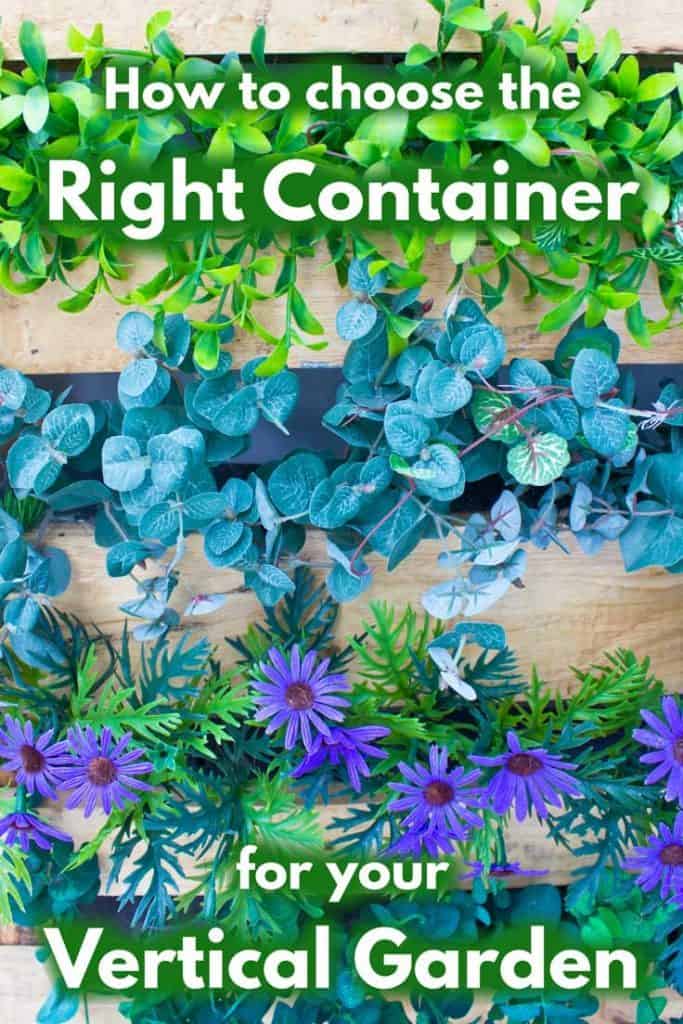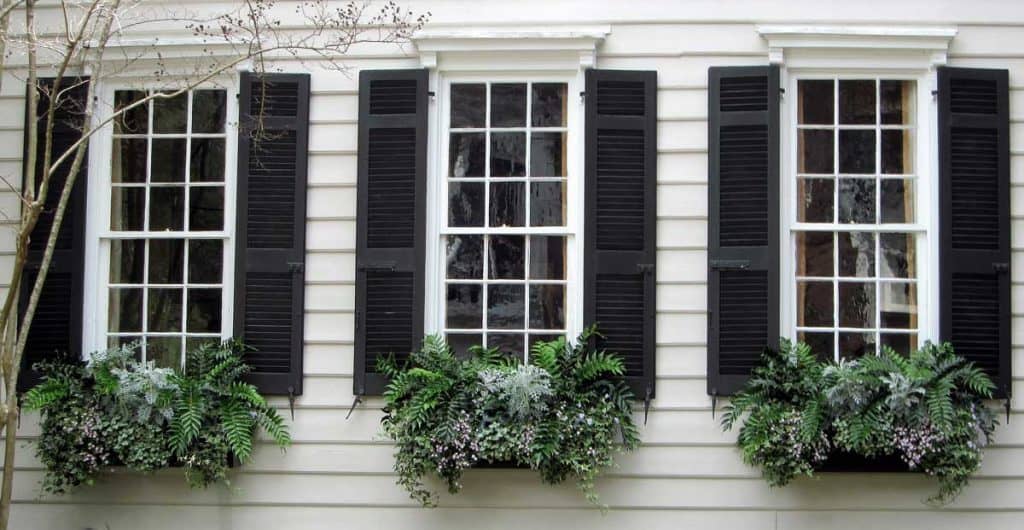Choosing the right containers for your garden is one of the biggest decisions that you need to make. I have been container gardening for years and am happy to share what I know with you!
 When choosing the right container for your vertical garden, there are a lot of options available:
When choosing the right container for your vertical garden, there are a lot of options available:
- Recycled cans, bottles and other mountable containers
- Recycled Wooden Pallets
- Window Boxes
- Gutters
- Fabric pockets
- Stacked planters
- Self-watering vertical garden system
- Straddling containers (for railings on porches or balconies)
All of these options may seem overwhelming, but it really is not that difficult as long as you have the information that you need to make the right decisions. Below, I have delved into these details to make it easy for you!
Creative Containers for Plants of all Kinds
When considering container planting, your plants need a container that will meet its growing requirements. This is pretty easy when it comes to vertical gardening, as the plants that do best in a vertical garden usually have a shallower root system. This enables the plants to grow in almost any kind of receptacle that has enough space for a little soil to tuck the plants into so long as it gets enough water and sunshine. For example, I once planted marigolds in fist-sized indentations on the sides of an old tree stump with a little potting soil and they did wonderfully!
Recycled Cans and Bottles other mountable containers
A quick visit to Pinterest will show you amazing vertical garden creations using all kinds of recycled or repurposed items. The plants themselves will spill over the top and sides of whatever you choose so not a lot will even be visible once the plants reach maturity.
You can use recycled cans, soda bottles, mailboxes, wooden crates, galvanized buckets, or metal boxes. If you can think of it, get it securely attached to a support structure, like a wall or fence, you can probably use it. Just fill with potting soil and plant. If your garden is outside, you will want to make sure that your containers have drainage holes in it so your plants down drown in a rainstorm. Just drill a couple at the bottom of whatever you choose and you should be fine.
Recycled Wooden Pallets
These look so incredible mounted on a wall or fence. In a pallet garden, a piece of landscape fabric is stapled across the back of the pallet, then it is secured in place. Fill it with potting soil, then plant in the openings. These are amazing for herbs or larger cascading type plants or vegetables that need a little more support and room than a soda bottle.
Window Boxes

Window Boxes are very versatile in that they provide a lot of space for your plants, and they can either be mounted directly on a wall or fence, or they can be stacked on a shelving type support. I like to use them for growing salad greens since you need a staggered planting in order to have a steady supply, especially of baby greens.
If you are wanting to grow flowers, window boxes also look fabulous filled with plants of varying height to create visual interest. Try combining geraniums, a shorter bedding flower such as Sweet Alyssum, and a cascading plant, like wave petunia for a spectacular display of color.
Gutters
Gutters are an easy and common means of creating a vertical garden on a wall or fence. You can use recycled ones or purchase new ones. Drill some drain holes, mount them on the wall and fill with potting soil.
Standard gutters are commonly 5 to 6 inches wide and deep, and you can extend each section to whatever length you prefer. This should give you plenty of room to plant most of your common flowers, herbs or veggies. You can find them in aluminum, galvanized metal, or even copper.
Fabric Pocket Planters
These have grown in popularity recently due to the ease of use and cost-effectiveness. They are basically a large felt sheet with pockets for soil and plants. The porosity of the fabric allows for airflow and drainage while still providing plenty of support for growing plants. These are an especially good choice if you are extremely limited in outdoor space. They can hang on a sunny patio or balcony wall with ease.
A few great examples are the Vertical Garden Hanging Planter by Living Gallerie and the Prudance Vertical Wall Garden Planter. Both of these provide sturdy construction and several pockets for a variety of plants.
Stacking Planters
A stacking planter is also a great choice for a small space. They are visually pleasing from all angles, and usually, consist of several sections so you can grow multiple types of plants. Depending on the size, you could use one as an indoor kitchen herb garden, or tuck a larger one into a corner of a balcony or patio to brighten up the area.

Trailing fruit such as strawberries do really well in this type of planter. The runners from the plants at the top of the planter will grow down and root in each of the other pots, creating a cascading effect of fruit and greenery. This also keeps the fruit off the ground, minimizing damage to the fruit and pests.
This 3-Tier Stacking Vertical Garden will hold multiple plants. Fill it with colorful cascading petunias for a waterfall of bounteous color all summer long.
Self-Watering Vertical Garden System
Perfect for the low maintenance gardener there are lots of self-watering vertical garden systems. These usually have a drip across the top level of the planters, which connects to a water tap. As it drips, the water collects in reservoirs in the levels of the planter, providing water for all of the plants on a continual basis, without drowning them.
These are not suitable for plants that are finicky about the amount or timing of their hydration. Ideally, one would not plant succulents, air plants, or any plant that only needs to be watered when the soil dries out. Most common annuals, herbs, and leafy green vegetable plants will do well with them, though.
Straddling Containers
These type of containers are crafted so that they sit steadily on porch or balcony rail. Just about any kind of plants can be grown in them, but like window boxes, are especially beautiful when filled with plants of varying heights.
Safety Considerations for Edible Plants
Even though plants can be grown in all kinds of different receptacles, it is important to keep in mind that some materials or exposure to chemicals can present a health hazard when growing edible plants. It is very important that you take the time to find containers that are safe for growing your fruits and vegetables.
Edible plants should not be grown in containers that are old enough to contain lead or lead-based paint, or asbestos. Beware of using flea market finds unless you can be certain that they were produced after lead-based paint and asbestos were removed from common use.
Another reason not to use vintage containers is the potential for contamination due exposure to harmful chemicals that you do not know about. If you don’t know its history, that cute bucket you found at the neighborhood yard sale could have been used for storing toxic chemicals or other dangerous products and you would never know it.
You can run into a similar issue with new plastic containers as well. Food grade containers are generally going to be safe for planting in, but you should avoid using containers with the recycling numbers 1, 3, 6 and 7. Do not use PVC plastic or polyvinyl chloride. The PVC pipe is an environmental health hazard and is toxic.
If you really love the look of an older container or a questionable plastic container, plant your edible in a cheap, safe pot and then tuck it inside the other one. You will get the same look without having to be concerned that harmful chemicals are leaching into the soil and taken in by your plant.
Making the Final Decision
Now that you have more information on the wonderful variety of containers that are available to you, it should be much easier to decide what you want to use to create your vertical garden. The design of your garden is limited only by your imagination. Be creative, be bold, and you will have a garden that you can be proud of.


